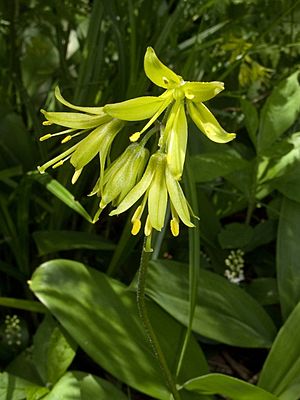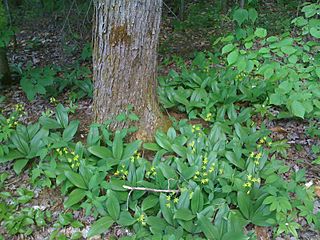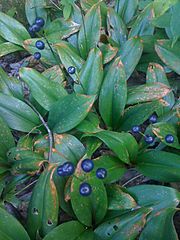Clintonia borealis facts for kids
Quick facts for kids Clintonia borealis |
|
|---|---|
 |
|
| Growing on Mont Tremblant, Quebec | |
| Conservation status | |
| Scientific classification | |
| Genus: |
Clintonia
|
| Species: |
borealis
|
| Synonyms | |
|
Synonymy
Clintonia aitonii Raf.
Clintonia angustifolia Raf. Clintonia biflora Raf. Clintonia biumbella Raf. Clintonia borealis f. albicarpa Killip ex House Clintonia borealis f. lateralis Peck Clintonia ciliata Raf. Clintonia falcata Raf. Clintonia fulva Raf. Clintonia glomerata Raf. Clintonia latifolia Raf. Clintonia multiflora Raf. Clintonia mutans Raf. Clintonia nutans var. 'dasistema' Raf. Clintonia nutans var. 'fascicularis' Raf. Clintonia nutans var. 'macrostema' Raf. Clintonia nutans var. 'obovata' Raf. Clintonia nutans var. 'prolifera' Raf. Clintonia nutans var. 'uniflora' Raf. Clintonia ophioglossoides Raf. Clintonia triflora Raf. Clintonia undulata Raf. Convallaria borealis (Aiton) Poir. Dracaena borealis Aiton Smilacina borealis (Aiton) Ker Gawl. |
|
The bluebead lily (scientific name: Clintonia borealis) is a beautiful flowering plant that belongs to the lily family. Its scientific name borealis means "of the north." This is a clue to where it likes to grow: in the cool boreal forests of eastern Canada and the northeastern United States.
People often call this plant bluebead, bluebead lily, or yellow clintonia. The name "bluebead" comes from its small, round, blue fruits, which are very noticeable. However, most plants in the Clintonia group have blue fruits. So, "yellow clintonia" might be a better name. This is because its yellow flowers are special and help it stand out from other Clintonia species. You might also hear it called yellow bead lily or yellow bluebead lily. Less common names include corn lily, poisonberry, or snakeberry.
Contents
What the Bluebead Lily Looks Like
The bluebead lily is a small plant, usually growing about 5 to 10 inches tall. It is a perennial plant, meaning it lives for more than two years. You often find these plants growing together in large groups.
Each plant usually has 2 to 4 leaves that gently curve and have veins running straight down them. The bright yellow flowers grow in small clusters at the top of a long stem. Each flower has six stamens (the parts that make pollen) and six yellow tepals. Tepals are like a mix of sepals and petals. Sometimes, a plant might have more than one cluster of flowers.
After the flowers bloom, the plant produces small, dark blue, round berries. These berries are mildly poisonous, so it's best not to eat them. Very rarely, you might find a bluebead lily with white berries instead of blue ones.
How the Bluebead Lily Grows
This plant can spread in two ways: by seeds or by underground stems called rhizomes. However, it spreads very slowly using either method. One group of bluebead lilies can cover an area as big as several hundred square meters.
Where the Bluebead Lily Lives
The bluebead lily is found across a large area in eastern North America. It grows from Newfoundland and Labrador in Canada, through New England, and west to the Great Lakes region in Manitoba and Minnesota. It also grows south into the Appalachian Mountains.
In the Appalachian Mountains, the bluebead lily grows in different areas than its close relative, the white clintonia (C. umbellulata). The bluebead lily prefers forests with pine trees or a mix of trees, often at higher elevations (up to about 5,200 feet). The white clintonia prefers hardwood forests at lower elevations.
Overall, the bluebead lily is a common and secure species. However, it is considered threatened in Maryland and Tennessee. It is an endangered species in Ohio and Indiana, meaning it is at risk of disappearing from those states.
How the Bluebead Lily Survives
The bluebead lily needs shade to grow; you won't find it in open, sunny places. Even though it spreads slowly, once a group of plants is established, it can usually survive many changes in its environment, as long as it still gets enough shade.
While cross-pollination (when pollen comes from another plant) is best for making seeds, the plant can also self-pollinate (use its own pollen) to produce seeds. This helps the plant keep growing even if there aren't other plants nearby.
Like many other slow-growing forest plants, the bluebead lily is very sensitive to being eaten by white-tailed deer.
Can You Grow It?
Growing bluebead lilies yourself can be tricky. They need shade, and their seeds are hard to get to sprout. It's also not a good idea to try and move them from one place to another.
What the Bluebead Lily Has Been Used For
Traditional Uses
The bluebead lily has been used in different ways by people for a long time.
- Medicine: The underground stem (rhizome) of the plant contains a substance called diosgenin. This substance has effects similar to estrogen.
- Food: The young leaves of the plant can be eaten when they are just a few inches tall. However, the blue fruits are mildly toxic and taste quite unpleasant, so they should not be eaten.
Folklore and Stories
The bluebead lily also appears in old stories and beliefs.
- Hunters in northern Quebec were said to rub their animal traps with the roots of the bluebead lily. They believed that bears were attracted to its smell.
- A tale from the Mi'kmaq people tells of a grass snake. When the snake eats a poisonous toad, it supposedly slithers quickly in circles around a bluebead lily plant to transfer the poison to the plant.
Images for kids





